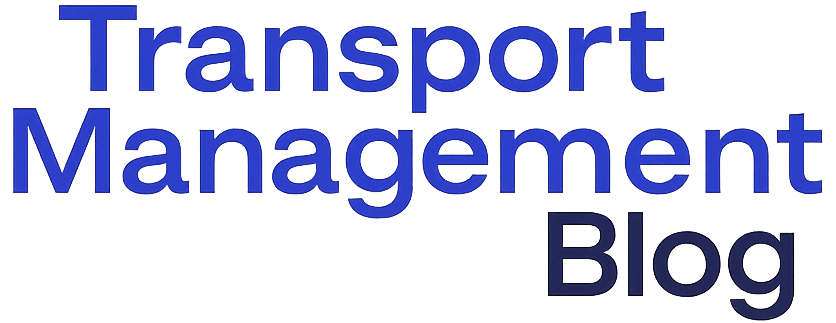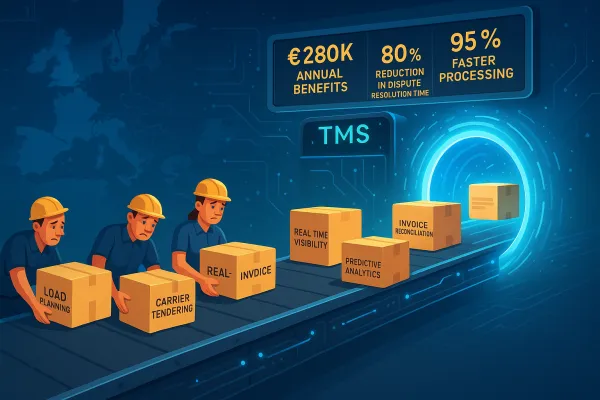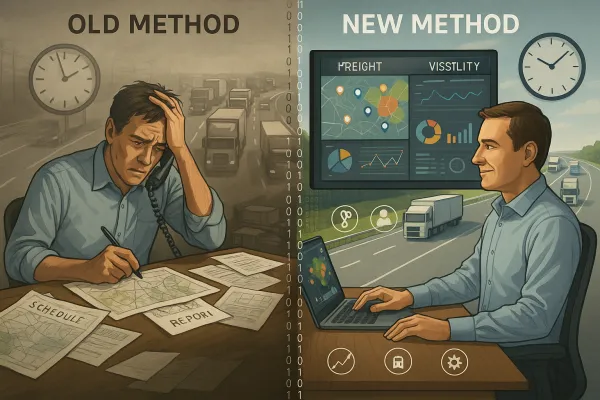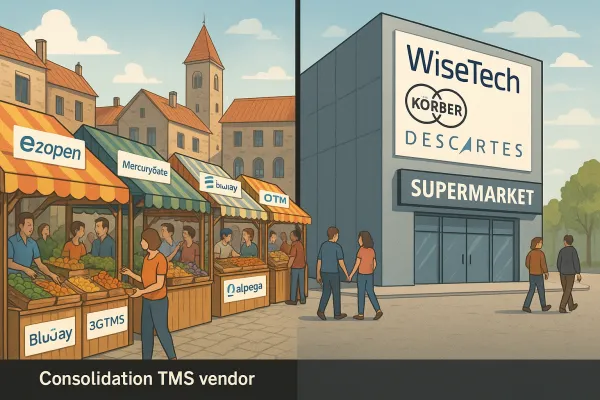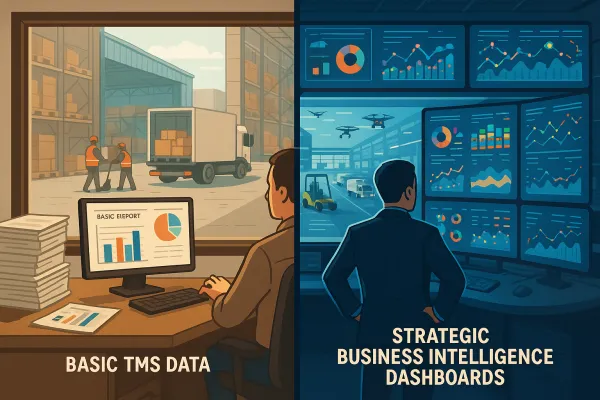ICS2-Ready TMS Selection: How European Shippers Can Choose Systems That Handle New Customs Requirements While Avoiding the 40% Implementation Failure Rate
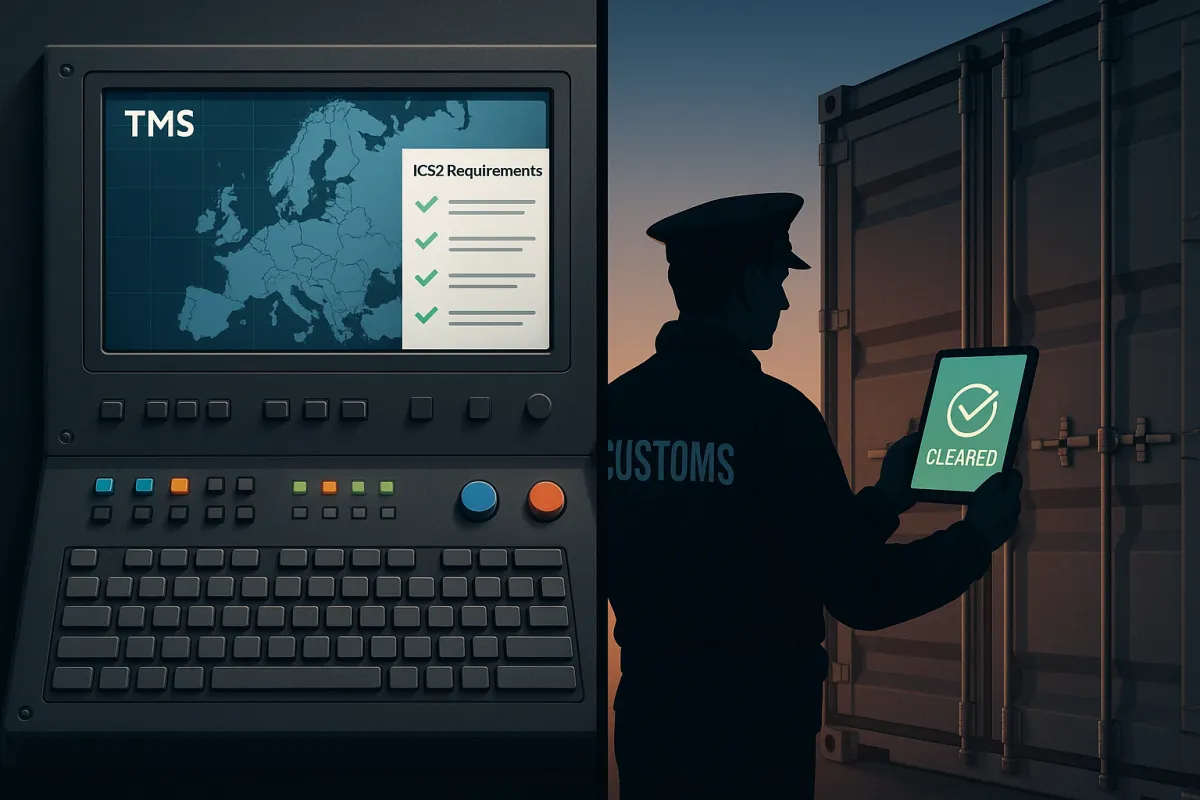
You've just signed off on a €200,000 TMS platform to handle ICS2 Release 3 compliance that went live September 1, 2025. Six months later, your team is still doing manual workarounds because the system can't handle the accurate and complete data required for every shipment at both master and house levels, and you're facing potential cargo delays at EU borders.
Sound familiar? You're not alone. More than 70% of organizations encounter roadblocks during TMS deployment, and with new ICS2 compliance requirements, the stakes have never been higher. Goods might be stopped at the EU borders and not cleared by customs authorities if traders don't meet the ICS2 requirements on time.
Here's what most European shippers miss: more than 50% of TMS adopters see positive ROI within 18 months, but the successful implementations share one critical factor - they chose ICS2-ready systems and avoided the common implementation pitfalls that plague the other 40%.
What ICS2 Release 3 Actually Means for Your TMS Requirements
The compliance picture changed dramatically on September 1, 2025, when ICS2 became fully operational across all EU Member States for every mode of transport. This isn't just about adding a few more data fields to your freight management system.
ICS2 mandates complete Entry Summary Declaration (ENS) data prior to arrival for all transportation modes, including road and rail carriers. The system now requires what customs authorities call "house consignment level data" - not just the basic transport information most legacy TMS platforms capture.
What does this mean practically? Your TMS must now handle dedicated ICS2 Declarant EORI fields with built-in validations and enforce strict six-digit HS code formats to meet filing standards. It needs to process up to nine CUS codes per pack line for harmless and dangerous goods chemicals.
Looking ahead, by the end of 2025, ICS2 Release 3 will extend multiple filing to all modes of transport, allowing different parties in the supply chain to submit partial ENS data. This means your TMS needs to coordinate between carriers and house filers for complete compliance.
The Hidden Cost of TMS Implementation Failures
The numbers tell a sobering story. More than 70% of organizations encounter roadblocks during TMS deployment, with 60% of firms reporting integration challenges that delay deployment timelines. But the real cost isn't just the delayed go-live date.
Consider this: TMS implementations typically cost $4.00 per shipment for volume users, with enterprise platforms requiring comprehensive evaluation using tools like Gartner's 38-page Magic Quadrant on the TMS market. When you factor in new carrier integration costs of approximately $3,000 per carrier and configuration fees for customizations and ERP system integrations, you're looking at substantial investments.
More than 50% of TMS adopters see positive ROI within 18 months, but that leaves a substantial portion wrestling with disappointing results. The successful implementations typically deliver 5-10% freight cost reductions, 20% dock utilization improvements, and 80% faster invoice processing.
Here's what drives failure: Approximately 70% of system integration failures arise from a lack of understanding of business needs, requiring software tailored around specific workflows rather than forcing transformation of existing processes.
Why ICS2 Compliance Makes Implementation Even Riskier
Non-compliance isn't just an administrative headache. The European Commission requires strict adherence to ICS2 filing instructions to avoid potential delays and penalties, with accurate and complete data essential for every shipment.
The compliance complexity is real: TMS implementation is an extremely complex undertaking involving routing, rate tables, communications between systems, vendors, customers, and departments - making today's TMS more than just a freight management system.
ICS2 Compliance Features Your TMS Must Have
Not all TMS platforms handle ICS2 requirements equally. The successful implementations we've analyzed share specific technical capabilities that go beyond basic transportation management.
Your system needs dedicated ICS2 Declarant EORI fields that enable users to designate filing parties with built-in validations to prevent errors. This isn't optional - it's mandatory for any discharge port in the EU, Northern Ireland, Norway, or Switzerland.
Advanced platforms like Cargoson and CargoWise have built these features natively, while others require costly customizations. CargoWise, for example, offers automated compliance features that simplify the process, helping ensure businesses meet ICS2 requirements with minimal disruption.
Key technical requirements include:
- Cloud-based data collection and validation systems
- Strict six-digit HS code format enforcement
- CUS code handling with error detection and correction prompts
- Automated ENS generation and submission workflows
- Real-time customs authority integration
Economic operators must ensure their IT systems and operational processes are fully aligned with ICS2 requirements, working closely with clients to understand new data requirements. The platforms that excel here don't just capture data - they validate it before submission.
Evaluating TMS Vendors: The ICS2-Ready Checklist
Here's where most buying decisions go wrong: teams focus on features that look impressive in demos rather than capabilities that matter for daily operations and compliance.
E2open claims one of the industry's largest networks with 400,000+ connected parties, including 6,000 rail and truck carriers, 800 ocean carriers, and 200 air carriers. But remember, adding new carrier integrations costs approximately $3,000 per carrier even with these large networks.
Compare this to platforms like MercuryGate, which provides access to over 10,000 carrier connections via EDI and API, though adding new carriers requires significant setup time and may involve additional costs. Oracle TMS, meanwhile, has no proprietary carrier network and relies on standard EDI connections, with new carriers requiring significant implementation effort through Oracle partners.
The total cost picture matters more than initial licensing: Oracle TMS typically starts at $250,000-$1,000,000+ annually, with implementation costs often exceeding $1,000,000. MercuryGate starts at roughly $4.00 per shipment and decreases as company volumes increase.
Modern European-focused platforms like Cargoson are positioning themselves alongside established names with specific ICS2 compliance features built for the European market. When evaluating vendors, consider:
- Carrier network size vs. integration costs
- Native ICS2 compliance features vs. customization requirements
- European regulatory expertise and local support
- Implementation timeline and resource requirements
- Total cost of ownership over 3-5 years
The Connectivity Cost Trap
Here's what vendors don't advertise: adding new carrier integrations costs approximately $3,000 per carrier even with the largest networks. This means your "connected" TMS might not connect to your preferred carriers without significant additional investment.
Platforms with smaller but more flexible networks, including newer entries like Cargoson, often provide better value by focusing on integration quality over quantity. Legacy platforms like MercuryGate face challenges with limited open API support, making integrations and automations very difficult to set up despite their strong logistics understanding.
Implementation Strategy: Avoiding the 40% Failure Rate
The difference between successful and failed TMS implementations isn't the software choice - it's the implementation approach.
Approximately 70% of system integration failures arise from lack of understanding business needs, while 60% of employees feel unprepared for new systems. The solution isn't more training sessions - it's better system configuration.
Successful implementations avoid poor planning decisions and flawed execution strategies, ensuring teams fully adopt the new system rather than fighting it. This requires TMS systems that feel like natural extensions of existing processes, not forced transformations.
Expert support during implementation proves critical. Companies like Missionpharma saw freight costs decrease while internal process efficiency improved 20-30% after implementing GoComet's TMS, with accurate shipment arrival predictions transforming customer relationships through enhanced supply chain visibility.
The Configuration vs. Customization Decision
Direct TMS purchases from software providers allow customization of key dashboard aspects, with long-term benefits often rendering additional implementation costs insignificant by automating logistics tasks and smoothing supply chain management processes.
However, data migration during integration can be time-consuming and prone to errors, making successful implementations prioritize integration architecture from day one rather than as an afterthought.
The key is finding platforms that offer extensive configuration options without requiring custom coding. Modern solutions from 3Gtms, Manhattan Active, Blue Yonder, and Cargoson excel here by providing templated workflows that adapt to business requirements.
Future-Proofing Your TMS Investment
The regulatory landscape will continue evolving. By the end of 2025, ICS2 Release 3 will extend multiple filing to all modes of transport, requiring coordination between carriers and house filers for complete and compliant filings.
AI-driven capabilities are becoming standard expectations, not competitive advantages. Modern TMS features that deliver under pressure include predictive analytics that identify shipment delays, port congestion, or rate hikes in advance by analyzing historical and real-time data.
Dynamic route and load optimization recalculates the most efficient routes based on traffic, capacity, and fuel prices, with platforms like GoComet automating this to cut delays and reduce excess costs.
The platforms positioned for long-term success combine compliance automation with operational intelligence. Growing data volumes in transportation and supply chain management drive demand for more effective processing solutions, with TMS increasingly using AI to track data in real-time and optimize efficiency through predictive analysis and cognitive visual recognition capabilities.
European shippers should prioritize platforms that understand the regulatory environment. While global solutions like E2open and Oracle provide comprehensive capabilities, European-focused platforms like Cargoson often deliver better regulatory compliance and faster implementation for mid-market manufacturers and wholesalers.
The AI and Automation Reality Check
Don't get caught up in AI marketing hype. Transportation challenges in 2025 demand more than visibility - companies need tools that predict, optimize, and automate with minimal intervention.
Focus on platforms that deliver practical AI applications: real-time multi-carrier rate comparison that displays rates side by side, helping teams choose the best cost-to-speed balance while preventing overpaying and building leverage during rate negotiations.
The most valuable AI features support compliance and cost control: carbon emission tracking that measures CO₂ per shipment, carrier performance analytics that score vendors on reliability rather than just price, and predictive capabilities that identify small deviations before they become serious problems.
Your next step? Create a shortlist focused on ICS2 compliance capabilities and implementation track record rather than feature lists. 80% of users prioritize fundamental functions like route optimization and shipment tracking when implementing TMS solutions - but in 2025, compliance capabilities separate successful implementations from expensive failures.
The 40% implementation failure rate isn't inevitable. Choose an ICS2-ready platform, plan your integration architecture upfront, and work with vendors who understand both European regulations and your operational reality. Your freight costs and customs compliance depend on it.
